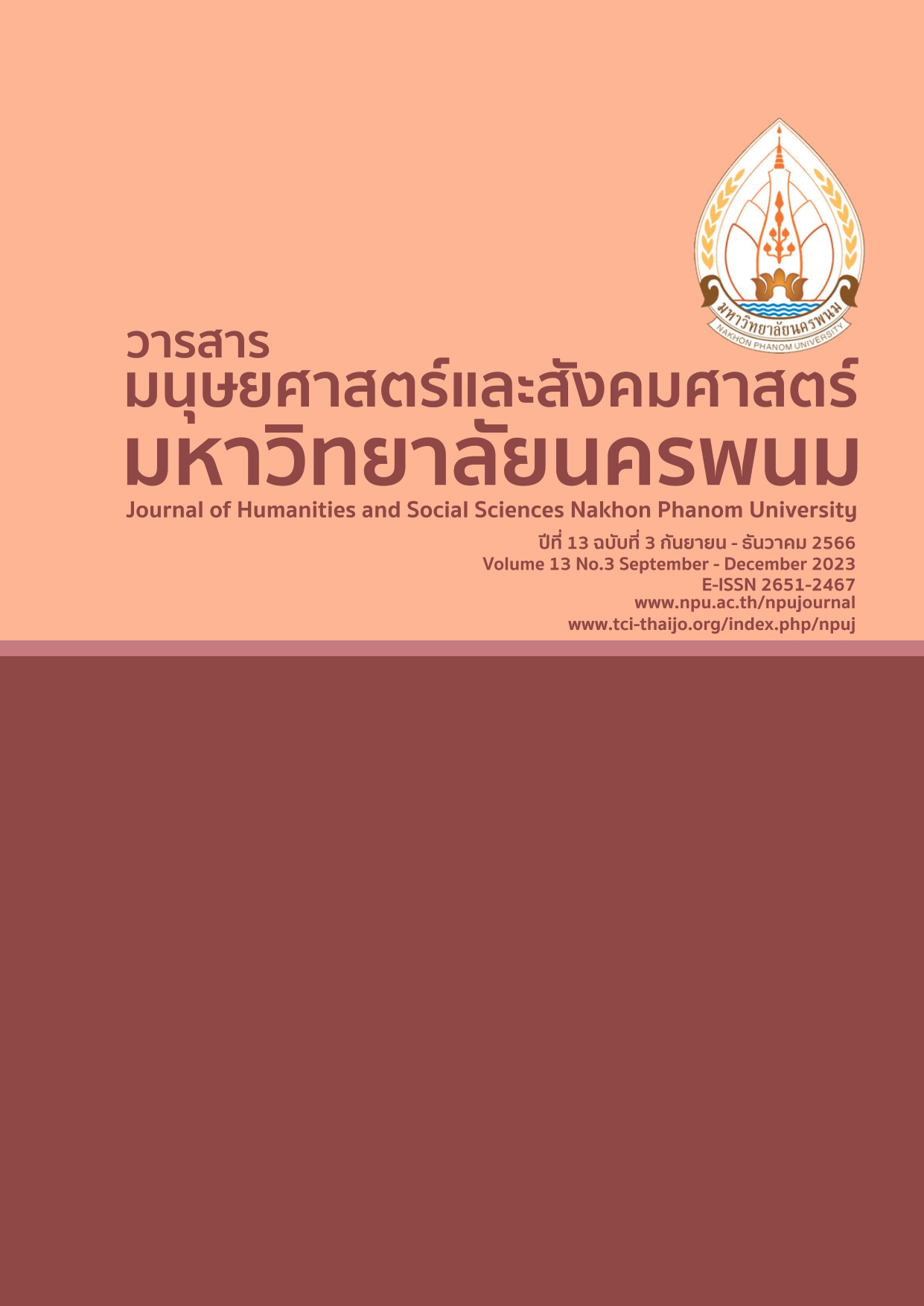COVID-19 Informative Communication Behaviors in Seekaew Sub-District, Meang Roi-et District, Roi-et Province, Thailand
Main Article Content
Abstract
The purpose of this research was to study the communication behaviors of Village Health Volunteers (VHVs) and residents in Seekeaw Sub-district, Mueang Roi Et District, Roi Et Province. This research used a mixed-method approach. A qualitative study was conducted from 44 VHVs using in-depth interview, along with a quantitative research which studied from 346 household representative. The research tool was a questionnaire. The research tool was qualitied by 3 experts. The value of content validity was 0.98 and the Cronbach's alpha coefficient was 0.75. The results of the qualitative research revealed that the VHVs had communication behavior on disseminating COVID-19 information from online media, especially www.google.com and the “MorPromt” mobile application. They also used offline media, including personal communication with Public Health Officers together with other media such as brochures, vinyl banners, community loudspeakers, and being role models in vaccinated experiences. The quantitative research found that the highest media exposure behavior of citizens was the offline media which 97.69% was the personal media, online media which 58.09% was mobile application, and the information utility behavior for self-preventing according to the D-M-H-T-T-A guidelines which 97.98% was physical distancing and wearing masks and the least one was 50.58% of ATK testing and Swab.
Article Details

This work is licensed under a Creative Commons Attribution-NonCommercial-NoDerivatives 4.0 International License.
References
Becker S. (1978). Discovering Mass Communication. Illnois : Scott Foresman and Company, Glenview.
Chanma, W. (2021). kānčhatkān kānsư̄sān nai phāwa wikrit wairat khō ranā sō̜ngphansipkāo khō̜ng samnak prachāsamphan khēt čhet Čhanthaburī [Communication management during the Coronavirus Crisis 2019 of Public Relations Office Region 7 Chanthaburi (Unpublished master’s thesis). Rambhai Barni Rajabhat University, Chanthaburi, Thailand.
Department of Disease Control, Ministry of Public Health. (2022). sarup phon kān chīt waksīn
khō wit sipkāo nai prathēt Thai : phon kānhai bō̜rikān wan thī siphā Makarākhom
sō̜ngphanhārō̜ihoksiphā wēlā 18.00 na.[Summary of COVID-19 vaccination results in Thailand: service results January 15, 2022 at 6:00 p.m.]. Retrieved January, 2022, from
https://ddc.moph.go.th/uploads/ckeditor2//files
Kusiyarungsitti, A. (2020). sư̄ thī chai nai kān ronnarong khō̜ng phāk rat phư̄a pō̜ngkan rōk rabāt khō wit – sipkāo khō̜ng prathēt Thai [Media used in government campaigns to prevent the spread of COVID-19 in Thailand]. Journal of Mass Communication Technology, Rajamangala University of Technology Phra Nakhon. 5(2), 77-86.
Klapper, J. T. (1960). The effects of mass communication. New York: The Free Press.
Merrill and Lowenstein. (1971). Media, Messages, and Men; New Perspectives in Communication. New York: D. McKay Co.
Ministry of Public Health. (2022). sathānakān phū titchư̄a COVID - sipkāo rāi phư̄nthī [Situation of COVID-19 cases by area]. Retrieved January, 2022, from https://ddc.moph.go.th/covid19- dashboard/?dashboard=province
Pinyosee, J. (2021). rapmư̄ khō wit - sipkāo patibat tām māttrakān D M H T T [Dealing with COVID-19 Comply with measures D M H T T]. Retrieved January, 2022, from http://www.msu.ac.th
Pathum Health Promoting Hospital, Ubon Ratchathani Province (2020). kān thō̜t botrīan ʻongkō̜n læ
chumchon rō̜prū dān sukkhaphāp thī mī kāndamnœ̄n ngān Tar naphai khō wit - 19, nūai bō̜rikān
: rōngphayābān songsœ̄m sukkhaphāp tambon pathum čhangwat ʻUbon Rātchathānī [Taking Lessons Learned from Health Aware Organizations and Communities with Operations Against COVID-19, Service Unit: Pathum Sub-district Health Promoting Hospital Ubon Ratchathani Province]. Lesson learned report of Pathum Subdistrict Health Promoting Hospital Ubon Ratchathani Province Between 19 – 21 August 2020, from https://hpc10.anamai.moph.go.th/th/dm-km/download?id=27857&mid=29987&mkey=m_document&lang=th&did=8320
Rattapan, S. (2021). patčhai thī kīeokhō̜ng kap kān tī trā thāng sangkha mō̜tō̜ phū titchư̄a khō wit - sipkāo khō̜ng prachāchon nai khēt ʻamphœ̄ thā sālā čhangwat Nakhō̜n Sī Thammarāt [Factors Related to Covid -19 Stigma among People in Thasala District of Nakhon Si Thammarat Province]. Journal of Health Sciences and Pedagogy. 1(3), 27-40
Rawinit, W. and Theppajag, P. (2021). kānpœ̄trap sư̄ kīeokap khō wit sipkāo čhāk krom khūapkhum rōk krasūang sāthāranasuk læ kān rūthao than khāo plō̜m khō̜ng phū rap sān [Media exposure about COVID-19 from the Department of Disease Control Ministry of Public Health And knowingly fake news of the audience]. National Academic Conference, Rangsit University Year 2021. Retrieved January, 2022, from https://rsucon.rsu.ac.th/proceeding/article/2682
Saiseesod, S. (2021). phrưttikam kānpœ̄trap khō̜mūn khāosān læ khwām tranak rū khō̜ng nakrīan naksưksā čhangwat ʻUdō̜n Thānī nai chūang wairat khō wit - sipkāo rabāt [Behavior of exposure to information and awareness of students. Udon Thani students during the COVID-19 virus outbreak]. Valaya Alongkorn Review Journal (Humanities and Social Sciences). 11(1), 13-25.
Sawasdiphon, C., (2012). theknōlōyī sārasonthēt læ kānsư̄sān [Information and Communication Technology]. Retrieved January, 2022, from
https://sites.google.com/site/chaipatcompanylimited/
See Kaew Municipality. (2022). khō̜mūn phư̄nthān khō̜ng tambon sī kǣo [Basic Information of Si Kaeo Subdistrict]. Retrieved January, 2022, from http://www.seekaew.go.th/info.php?id=2
Tato, R. (2018). kānwičhai thāng phayābān sāt nǣokhit sū kānprayukchai [Nursing Research: Concepts to Application]. 3rd edition. Bangkok: Chulalongkorn University.
Traimongkolkul, P. and Chatraporn, S. (2012). kānʻō̜kbǣp kānwičhai [Research design]. Bangkok: Kasetsart University.


